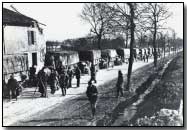Encyclopedia - Voie Sacree
 La Voie Sacree -
which came to be called the 'sacred road' and was simply called 'La Route'
at the time - comprised the main road supply artery used by the French Army
and which ran from Bar-le-Duc to Verdun.
La Voie Sacree -
which came to be called the 'sacred road' and was simply called 'La Route'
at the time - comprised the main road supply artery used by the French Army
and which ran from Bar-le-Duc to Verdun.
Some 60km in length and with an average width of 7 metres this minor road, surfaced with crushed stone, saw a continuous, congested stream of army supply vehicles pour bumper to bumper into Verdun once the French government determined at an early stage that the ancient city was to be held at all costs against a ferocious German offensive launched in February 1916.
The German Verdun Offensive - geared as a means of 'bleeding France white' by Germany Army Chief of of Staff Erich von Falkenhayn - ultimately resulted in almost one million casualties, around half of which were fatalities. France's determination to retain control of Verdun was matched by von Falkenhayn's resolve to capture it; the failure of the latter ultimately cost Falkenhayn his job.
The task of maintaining the vital supply route to Verdun - designated as such and overseen by Henri-Philippe Petain from March 1916 - fell to numerous Territorial divisions (numbering 8,000 men in all), who patrolled its length, constantly repairing road defects as they arose.
Meanwhile seven Nieuport aerial fighter squadrons were positioned to similarly defend the road - which was divided into four zones - from aerial bombardment from several small airstrips established for the purpose. German artillery nevertheless engaged in constant remote bombardment.
A separate light railway system was also operated as a means of directing troops and supplies into Verdun, but La Voie Sacree (a name coined after the war by writer George Bernanos) remained the key route throughout 1916.
As an indication of the importance of the route selected statistics tell a startling story: up to 90,000 troops travelled via the road each week, together with around 50,000 tons of ammunition in 12,000 trucks. Traffic continued day and night with trucks moving at an average speed of 25 kilometres per hour. Trucks which broke down were rapidly hauled off to the side of the road in order not to halt the advance of supplies - which were predominantly artillery in nature.
The French were ultimately successful in defending and maintaining the road - adding some 700,000 tons of additional crushed stone by the end of the battle, most of it dug by German prisoners of war. The Verdun Offensive finally called off in failure by the Germans in December 1916. German failure coincided with the dismissal of Falkenhayn and his replacement by the effective combination of Paul von Hindenburg and Erich Ludendorff, both freshly arrived from a successful campaign on the Eastern Front.
The road is today maintained as a national monument by the French government.
Around one million Indian troops served in WW1, of which some 100,000 were either killed or wounded.
- Did you know?
